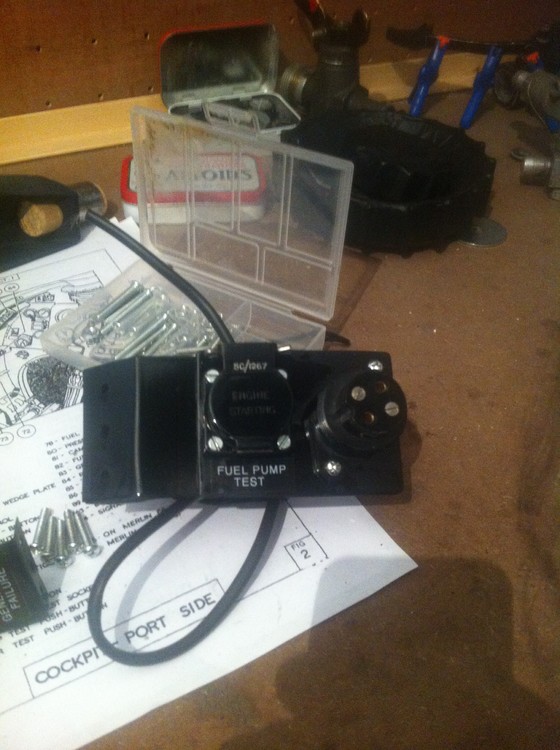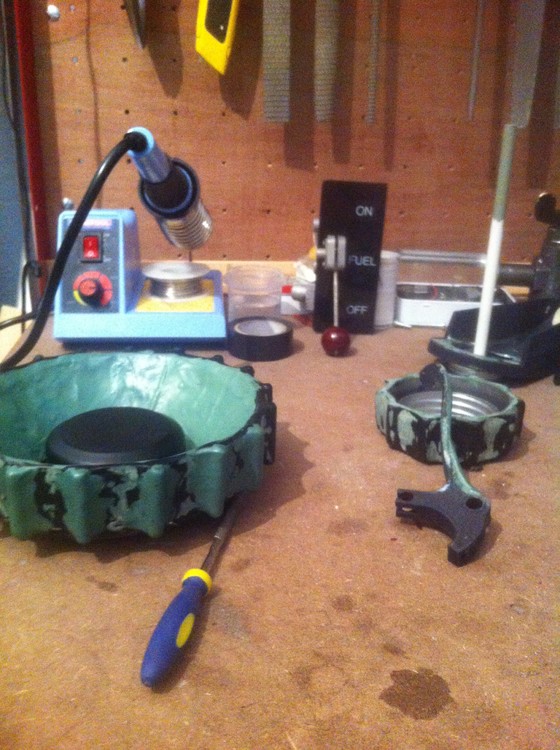

Cripple
Members-
Posts
323 -
Joined
-
Last visited
-
Days Won
1
Content Type
Profiles
Forums
Events
Everything posted by Cripple
-
Here's a pic on the Standard Beam Approach, as used by the RAF in WW2. This is from AP 1732b, Advanced Flying Training - more info available upon req.
-
What he said... Had a thought whilst in the bath: what if the term "auto" is a red-herring? A constant-speed prop is already "auto" to all intents and purposes - set the desired rpm and forget (see linky below); and the spitfire had a constant speed prop from August 1940. NB: this is not the same as the variable pitch prop some of you are referring to - the constant speed will cope with over/under-speeding So what changed? I was looking at the PNs for the mk IX and started comparing the advice for flying economically for auto/manual props (section 3, paragraph 55). The number of 2650 rpm pops up consistently, which is coincidently the max continuous rpm of the engine at cruising (+7) boost. Okay, here's the wild theory: what if nothing changed? Or rather, what if the odd brass stop I described (as evident in later "auto" models), that prevents the airscrew controller from going further aft that the vertical, is just that - a stop... that prevents the rpm being reduced below 2650 (an rpm the Merlin seems comfortable burbling along at indefinitely, or at least until the fuel runs out). Not so much an "automatic", as a "you really don't need to pull it further back than this and confuse things, Mr Combat Pilot". Whilst still allowing one to push it forward to engage a higher RPM if required. How can we test this theory? See if the "manual" spitfire maxes out at that rpm with the lever in the same position. Anyone got one handy?:music_whistling: http://www.boldmethod.com/learn-to-fly/aircraft-systems/how-a-constant-speed-prop-works/
-
A silver B17 mock-up was shown at one point...
-
Hmmmm. I think we may have been talking at cross-purposes here: I don't think anyone has implied that the (Spitfire) airscrew control wiggles about whilst set to "automatic". My reading of the PNs was that the lever in the cockpit is either set to auto (where it remains) or one can advance the lever as a manual override. The quasi-magical moving bit of it is all at the other end of the control cable, at the airscrew. As you say though, this is all base speculation... I too look forward to seeing how ED has chosen to implement it. :) (PS - Some of the 737 lads build "magic" self-moving throttles and trim-wheels, don't they?)
-
Likewise. That's been my reading of the info. Fully-aft for auto, but with a manual override if you advance the lever any.
-
Could we keep this related to the Spitfire, please? :) Okay, I'm throwing down the gauntlet here: can those of you who support a physical linkage at the throttle quadrant kindly provide evidence that this was the case in the mk IX Spitfire? (Andy, Alan... I'm looking at you...) I'll admit it certainly seems like the simplest and most logical explanation. However, I have been through my copies of the flight manuals, period plans, contemporary photos, and Monforton's rather excellent book... and I can find no evidence that the throttle lever was physically connected in any way with the airscrew control. If people are interested I can post the relevant pics, but take my word for it: the airscrew lever is entirely inboard of the plating on the throttle quadrant, this plating does not have an opening that might allow for a connecting lever, the throttle lever itself is only pierced for mounting the L-plate that flips the master switch, and the airscrew control connects directly by Teleflex to the airscrew mechanism. I have seen two type of metal object external to the throttle quadrant plating that interface with the airscrew control: the first is a simple spring plate that retains the airscrew control in its aft-most position (and seem to be for earlier - fully manual - aircraft, as it seems to be removed by "mod spit.1026" in 43/44), while the second is a brass plate with a solid stop to prevent the airscrew being moved aft of the vertical (which seems to be for the later - automatic - aircraft, and can assumed to be the above modification). Neither of them penetrate the plating or interact with the throttle lever. Anyone got any info on the Rotol airscrew end of things? That might help...
-
^^ Thumbs up. Ta.
-
Found this manual for the TR 1143A WW2 aircraft radio. Of particular interest to myself was the information on the Type 3 Controller (paragraphs 14 & 80 onwards) - now I know what the "REM" setting on mine is for! There's also a wee bit of info about the Beam Approach (paragraph 20), and if anyone actually has AP2528E then please share. :) Can't upload, but here's the linky-linky: http://www.vmarsmanuals.co.uk/archive/1601_TR1143A_Vol_1.pdf
-
Hope so! That's an integral part of these engines' start-up. Smoke, and even flames if you over-prime them.
-
Anyone got any more info on it? Like the AP or the plans? Devs? I'm certainly very interested in finding out more. (For the record, I prefer the idea of flying a "manual" prop anyway.)
-
Really? Interesting... I'd somehow got the idea that the merlin 66's onwards had the interconnected throttle and prop controls, as described in paragraph 20 of the pilots notes: http://www.zenoswarbirdvideos.com/Images/spit/SPIT9MANUAL.pdf
-
Yes, up to a point. There's a switch plate for the beam approach equipment (although no switch....) visible in one of the leaked cockpit shots - starboard side, immediately for'ard of the wobble pump. I believe it was for a Lorenz-style aural dit-dah blind approach. There was also "Darkie", where a pilot could be talked down to the nearest airbase on an emergency channel. Pretty much as NeilWillis put it... :P
-
Or get the drop on the bugger... You know, like they did IRL.
-
Anyone else just a wee bit delighted that DCS: Spitfire is finally out? :D Anyway, apologies for the lack of updates. It's all bit rather bitty work. A wee bit here, a bit there... So, what have I got to share then? The last of the test buttons, the oxygen regulator (reamed out a radiator key to fit over a potentiometer - works well), and a quick shot of my workbench. Still finishing off the trim wheels, and I've reinforced the brake lever with a strip of metal glued to the reverse and smoothed over with green stuff. Oh, and there's the "close-enough" fuel cock I've repurposed. Think I've broken the back of the throttle quadrant project too - pics to follow when I'm further along.
-
I don't usually pre-order... but... bought her! :D Thanks ED for bringing us a mkIX Spitfire, and for Xmas too! :)
-
Lol - yes... but the former is for commissioned officers only. :thumbup:
-
Ooooooo! :D
-

What is the possibility of a BoB scenario.
Cripple replied to hnbdgr's topic in Western Europe 1944-1945
Who? Never heard of him/her/them. Is this something to do with the WW2 Kickstarter that went belly-up? The matter of the late-war aircraft/maps seems pretty simple to me. Either: A) This is ED's decision, in which case it should be open to debate. Or, B) This isn't ED's decision, in which case they don't have to stick to it. Whilst Joe Public may certainly have heard of the Normandy Invasions, it seems... illogical... to start one's WW2 setting at that point. Similarly, the desire of some people to have the "best" model of a particular aircraft not withstanding, it seems to have been a curious decision to do the late-model German fighters first. (NB: Kev2Go, "definitive" does not necessarily equate to newest/fastest/whatever. Rather it would be the model that defines the design. One could argue that the definitive model of Spitfire was the mk V, the mk IX or even the mk II. These are what people think of when they hear "spitfire", rather than the later griffon-engine bubble-canopied models.) I digress though. Here's a question: would you rather upgrade your favourite aeroplane, or downgrade her? Or, to put in another way, would it not be more sensible to start with scenarios and aircraft from the start of the war? That way, ED could release new content that would allow people see how the aircraft were refined, rather than - for lack of a better term - going backwards with new content? -
Nice work. :)
-
Heard of, yes; been there, or want to go there... er, no. Mind you, I've heard of Siberia too, but I wouldn't get excited over the place names. Put it this way, I didn't even know there had been a "Russian invasion of Georgia in 2008" until I read the DCS blurb. Same place, innit? I mean, Uncle Joe (Stalin) was a Georgian/Russian/Whatever. Now, I know that ED are a Russian outfit, so it probably had a spot more relevance to them than it does to me. However, one has to think of bums-on-seats; where has the buying public heard of? By way of example, if a British company was to produce a Falklands-themed map that might well tug at the heartstrings of Brits (and Argentinians, wanting Round 2), but I doubt that many other people would find the drab mountainous terrain particularly interesting to fly over. Normandy? Good choice, from that perspective. Varied terrain, and more people tend to have heard of A) WW2 and, B) France. Hence why it might be a good idea to get it up and running on the basic install asap.
-
Well said! :) I suspect that (IRL) having bits of metal pinging off the metal box one is sitting in is not the most conducive to maintaining one's morale...
-
Hear, Hear! ED are missing out on $$$ here. I've been on the cusp of buying The Vegas Map quite a few times just for pootling around sight-seeing, but I'm not downloading an "early access" (or what we used to know as a Beta Release) to play it on - particularly as it seems to be an entirely separate install. I'll stick to flying over Neverheardofitistan instead. I do hope Normandy et al will be released to run on the current general release of the game, or they will not be bought until they are! (It seems now that poor 2.0 won't even get a general release, being leapfrogged by 2.5...)
-

What is the possibility of a BoB scenario.
Cripple replied to hnbdgr's topic in Western Europe 1944-1945
Personally, I'd love one too. Or even just a cross-channel map to add a spot of added spice. Not quite sure why there is this focus on the last year of the war, and the early not-quite-ready-for-the-war jets, when there are *years*-worth of WW2 aircraft to model prior to D-Day. The war in Europe didn't start in '44. Actually, those of us from the UK learn that WW2 started in '39 - not '41, when the US and USSR finally rubbed the sleep from their eyes... -
Good luck with that. The Spitfire doesn't have a bomb sight...
-
Remind me what the role of the Spitfire (IX or otherwise) was? I don't seem to recall "tank hunter" was on Mitchell's original design brief. Hence why I'm not wetting myself over Tigers, Panthers, Ocelots, Ginger Tomcats, or any other (tracked) felines. Particularly not in rivet-counting high-definition...




